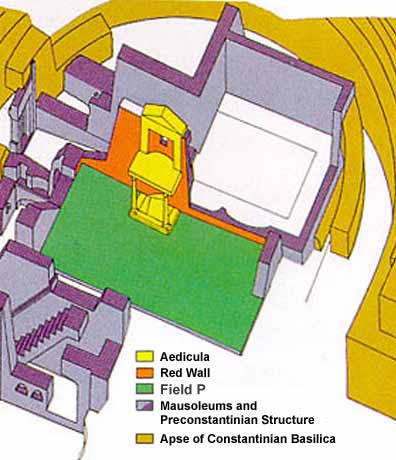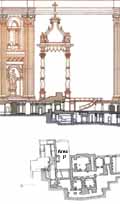
|
From:
'Guide to the Vatican Necropolis' by Michele Basso,
© Fabbrica di S. Pietro
The
area known as Field P was the most venerated part
of the cemetery; in fact, various tombs surrounded
it, both respecting and honouring it, the tomb of
St. Peter. A simple tomb, dug out of the ground, it
is situated in the very centre of all the others because
it was the tomb of the Apostle St. Peter, martyred
during the persecution of Nero in the Neronian Gardens,
between 64-67 A.D. This site has been the object of
indisputable continuous veneration of the Church from
the first century. Evidence has been confirmed by
the discovery of walls and architectural materials
which surrounded and rose above this sacred burial
place.
|
From:
'The Tomb of St Peter'
by Margherita Guarducci
This little area which, in relation to the modern basilica,
is directly under the Confession, was called "Field P" by
the excavators. It is rectangular in form (about seven meters
from north to south, about four from east to west), and
it lies in a place where the terrain rises quite rapidly
from the south to the north, i.e. toward the Apostolic Palaces,
and more gradually from the east to the west, i.e., toward
the Vatican Gardens.
Field
P is bounded on the west by a wall called "Red" because
of the red color of the plaster (now largely fallen off)
which was used to cover it; on the south by a tomb which
the excavators call S; on the east, but only in the southern
half of the east section, by another tomb called O (this
tomb was owned by the Matuccii and is sometimes called by
their name). The northern boundary of the eastern side and
all the northern boundary of the eastern side and all the
northern boundary cannot be traced today, but there are
good reasons for believing that there were once structures
there which have been mostly destroyed.
The
most ancient of the tombs surrounding Field P is certainly
Tomb O, which, as can be seen form the marble tablet over
the entrance, belonged to the Matuccii family. This tomb,
in which the rite of cremation was practiced, can be dated
about 130, and is certainly later than 123, since a brick
was found in one of its walls with a seal dating from that
year.
Field
P was full of burial tombs. Some of these were brought to
light during the 1939-1949 excavations; others in much greater
numbers, by the successive excavations of the years 1955-1957.
These tombs are generally quite modest, situated in the
bare ground with little or no protection. Some of them are
certainly older than the Red Wall, i.e., as I have explained,
before about 160 A.D. One of these is the tomb indicated
by the excavators with the Greek letter gamma ( ):
a child's tomb which extends partly under the Red Wall,
which shows that it must be older than the wall. A precious
clue to establish its date comes from a seal pressed into
one of the tiles covering it. The seal is dated by scholars
at the beginning of the second century (about 115-123),4
and it is quite probable that the tomb is not much later
than this date. Tomb gamma is also interesting because one
of its walls contains a terra cotta tube through which libations
were poured from the outside in honor of the deceased. This
is essentially a pagan custom, but it was adopted for a
while by some Christians.
):
a child's tomb which extends partly under the Red Wall,
which shows that it must be older than the wall. A precious
clue to establish its date comes from a seal pressed into
one of the tiles covering it. The seal is dated by scholars
at the beginning of the second century (about 115-123),4
and it is quite probable that the tomb is not much later
than this date. Tomb gamma is also interesting because one
of its walls contains a terra cotta tube through which libations
were poured from the outside in honor of the deceased. This
is essentially a pagan custom, but it was adopted for a
while by some Christians.
Other
tombs in Field P can be dated earlier than the Red Wall.
They are usually designated by the Greek letters eta ( ) and theta (
) and theta ( ). The first is certainly more ancient than the Red Wall
since the two little columns of St. Peter's Memorial are
placed on it, and this monument, as I shall explain in a
moment, is contemporary with the Red Wall. The second of
these tombs (theta) is under Tomb eta and so, necessarily,
earlier. In addition, Tomb theta has, on one of its tiles,
a seal that can be dated in the time of the Emperor Vespasian
(69-79). This seal was already discussed in the chapter
on the Vatican in antiquity;5 and the fact that this tomb
belongs to the first century is unquestionable. In addition,
the existence of first-century tombs in this part of the
Vatican necropolis is confirmed, as I have said,6 by other
documents, particularly by a lamp that can be dated with
certainly in the first century, found with other funeral
material from the same period in the immediate vicinity
of Tomb theta.
). The first is certainly more ancient than the Red Wall
since the two little columns of St. Peter's Memorial are
placed on it, and this monument, as I shall explain in a
moment, is contemporary with the Red Wall. The second of
these tombs (theta) is under Tomb eta and so, necessarily,
earlier. In addition, Tomb theta has, on one of its tiles,
a seal that can be dated in the time of the Emperor Vespasian
(69-79). This seal was already discussed in the chapter
on the Vatican in antiquity;5 and the fact that this tomb
belongs to the first century is unquestionable. In addition,
the existence of first-century tombs in this part of the
Vatican necropolis is confirmed, as I have said,6 by other
documents, particularly by a lamp that can be dated with
certainly in the first century, found with other funeral
material from the same period in the immediate vicinity
of Tomb theta.
All
these tombs of Field P are, for us, anonymous, since none
of them has preserved an epigraph in which the name of the
deceased is indicated. But it is quite probable that in
ancient times the names (at least some of them) were carved
on tombstones rising out of the ground and that these were
later lost during the many vicissitudes of the region.
From:
'The Shrine of St Peter and The Vatican Excavations' by
Toynbee and Perkins
The Aedicula faced onto, and was intimately connected with,
an open space or courtyard, 'P' (referred to in the Report
as 'Campo P'), the greater part of which underlies the sixteenth-century
Open Confessio... The limits of P were in part determined
by pre-existing structures, on the south by the north wall
of Tomb S, and on the east, for some length, by the outer
wall of the staircase flanking Tomb O. The north wall seems
to have been destroyed at quite an early date within the
Middle Ages, probably in connection with the construction
of the Covered Confessio, but its position can be determined
from the surviving traces of the return of the plaster facing
at the point where it abutted against the face of the Red
Wall, near the northern angle of Tomb Q. The northern part
of the east wall has not been traced; but it is a reasonable
assumption that it was carried northwards from the north-west
angle of O, delimiting a roughly rectangular area, a little
more than 7 metres from north to south by nearly 4 metres
from east to west. The entrance to this area, which was
open to the sky and does not seem at first to have had any
formal paving, must have been either from the north or,
rather more probably, in view of the lie of the ground,
from the east, behind and above Tomb O; how steep the slope
was can be gauged from the fact that the floor of P and
of the Aedicula, which wa almost exactly level with that
of the tessellated pavement of Q, was over 3 metres above
that of O.
Sources
P. Zander. The Vatican Necropolis, in "Roma
Sacra", 25, Roma 2003
Margherita Guarducci, The Tomb of St Peter, Hawthorn
Books, 1960
John Evangelist Walsh, The Bones of St Peter, New
York, 1982
J. Toynbee - J.W. Perkins. The Shrine of St Peter and
the Vatican Excavations, London 1956
Michele Basso. Guide to the Vatican Necropolis, Fabbrica
di S. Pietro in Vaticano, 1986




